The Ancient Civilizations that Came Before:
Self-Eradication, Or Natural
Cataclysm?
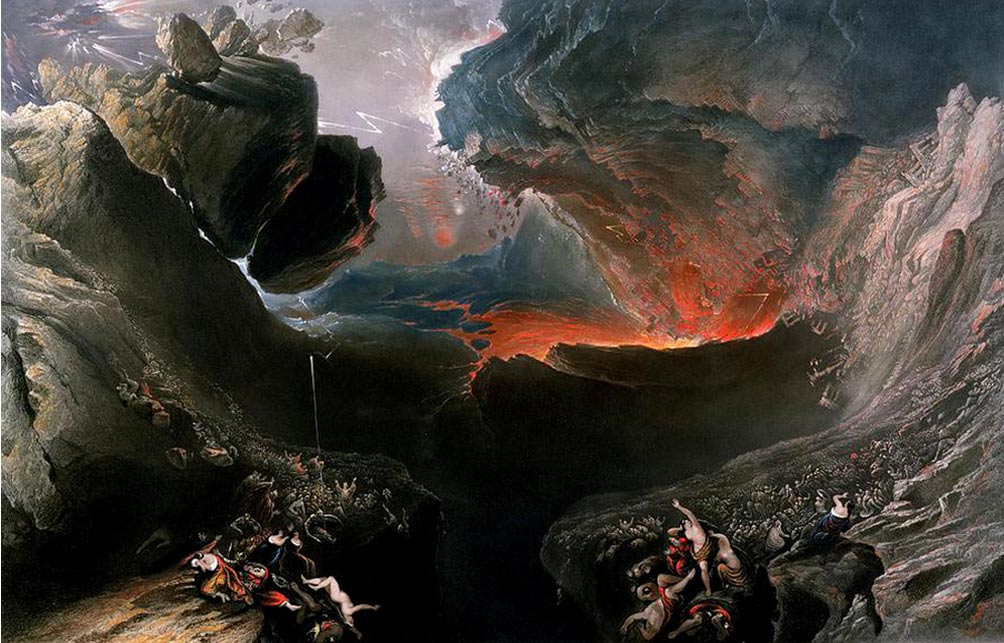
John
Martin's The End of the World, which depicts the "destruction of Babylon
and the material world by natural cataclysm”. (Public
Domain)
Humanity has grown so old that it has forgotten its infancy, and the origin of man is shrouded in mystery.
Conventional wisdom states that humanity was primitive in the past and then things started evolving until people emerged from the state of barbarism to become smarter and more capable. New evidence however suggests otherwise; it suggests that maybe the dawn of history was characterized by forgotten high science and technology that far exceeds modern man’s expectations of the distant past.
This view is as old as history. The ancients spoke of their past as being glorious. The account of Atlantis in Plato’s dialogues Timaeus is the most vivid memory we have of this golden age.

Medieval manuscript of Plato’s Timeas, Latin
translation. (Public
Domain)
A few years later in 1929, a mysterious map from 1513 called the Piri Reis map was found in Istanbul. The map shows the coasts of Antarctica and South America with modern exactitude. This map rekindled the view on advanced ancient civilizations and gave it a solid ground.
More recently the book ‘Worlds Before Our Own’ (1978) by Brad Steiger exposed new facts in favor of early advanced societies. Steiger found that some advanced human artifacts were located in the lowest primordial geologic strata whereas primitive ones are in upper strata. He labeled these anachronistic items that were seemingly out of their proper place in time, “Out-of-Place Artifacts”(OPA). His book fueled a series of later works that characterized the past 30 years with a sort of rebellion towards the current worldview of the ancient past.
If advanced societies did exist, what then brought about their destruction? There are mainly two possible past events. Either these people were so advanced that they destroyed themselves, or a natural force brought about their destruction. The evidence in favor of the second event is more substantial than the first. There are however some indications of ancient warfare.
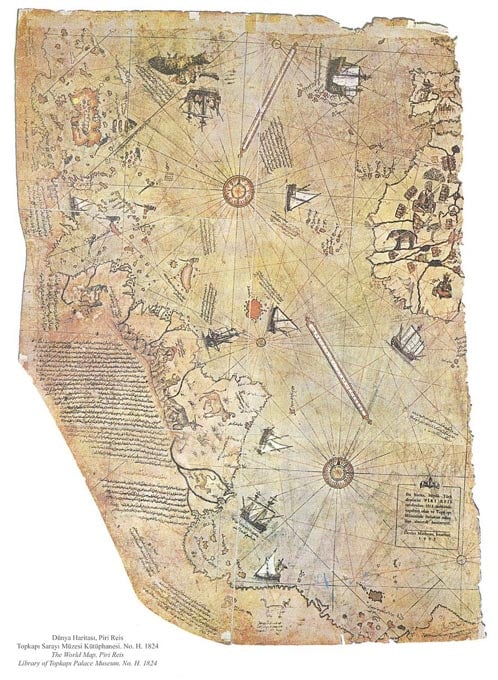
Map of the world by Ottoman admiral Piri
Reis, drawn in 1513. (Public
Domain)
Ancient Creation and Destruction
-
(New
York Herald Tribune, 1947)
Uniformitarianists would not agree on the second scenario, that ancient civilizations might have been destroyed by natural forces. They speculate that the current earth features are the result of a process of millions of years. Cataclysmists on the other hand claim that these features are legacies of a worldwide catastrophe.
The uniformitarianist view however suffers some problems and inconsistencies, for example the inaccuracy of carbon dating. This dating method presupposes an already established balance between the forming and decaying of radioactive carbon that has been maintaining its equilibrium for millions of years in earth’s atmosphere. The C14 forming however is actually greater than its decaying. No state of equilibrium has been reached yet. As a result, the C14 ratio in the atmosphere (0.0000765%) cannot scientifically be used as a benchmark in dating fossils. In other words, we cannot know the age of fossils by which we determine the age of earth strata. Therefore, we cannot be certain about the actual age of the earth features.
A second example is the vertical petrification of trees running across multiple earth geological layers that are “supposed” to be belonging to different earth epochs. These penetrated layers could only suggest that they were formed in a short period of time, a result of a rapid cataclysmal sedimentation for example, but not a process of millions of years, otherwise the petrified trees would just be an impossibility.
Another example is the striking similarities found in myths and legends across the globe of a worldwide cataclysm—more specifically a deluge. Many similar myths on this account are found in Africa, China, North America, Australia, Sumeria, and in very remote cultures that had no way to connect with one another. It is estimated that are more than 500 ancient deluge legends similar to those mentioned in the Biblical and Qur’anic accounts. These myths are actually traces of a global collective memory referring to an actual occurrence in the distant past. Add to that the genetic evidence for a past near-extinction event that took place thousands of years ago, also known as population bottleneck event that supports the cataclysm view.

The deluge or great flood myth is found in
cultures around the globe. (Public
Domain)
The Golden Age of Skepticism and Scientism
“Extraordinary claims require extraordinary
evidence.”
—Carl Sagan
The postmodern world is a golden age of skepticism, relativism, materialism, presentism, obscuritarianism, and scientism. Such extraordinary claims would not make it to the public attention; not because the evidence is insufficient or invalid, but because it is prejudged by the current biased philosophical view of the modern age. Consequently the claim is not pursued and remains in the realm of pseudoscience. Believing in such claims presupposes a destructive event that ruined the face of the earth, thus the challenge of finding the evidence to prove it is even greater.
However, how much do we really know about the earth? We so much take the earth for granted; we think we know every inch of it when we do not even know ourselves. Absence of evidence is no evidence of absence. Dr. Melvin Cook, accomplished chemist and Nitro Nobel medalist, concluded that the earth underground oil deposits were formed as a result of a sudden and rapid burial of organic materials just a few thousand years ago. Could it be the case that underground oil deposits are prehistoric cities that turned into oil due to the sudden sedimentation and high pressure?
New Ways of Thinking
The mighty pyramid of Khufu silently speaks louder than the chatter of skeptics. It is aligned to true geodetic North and its location is found to be the center of the earth landmass. This sort of precision entails a comprehensive knowledge of earth geography, e.g. mercator projection, which is something very unexpected of ancient Egypt. As for its structure, engineers and scientists conclude that it is impossible to replicate the great pyramid despite the sophisticated technology we have now, given the structure’s immensity and staggering precision.
Speaking in numbers, engineer Markus Schulte speculates that the Great Pyramid alone would cost us some $35 billion. Investing such money in a colossal structure—one that is not even habitable, and without any expected profit—is something we certainly would not do today. In that sense, the question ‘how was it built?’ is less important than ‘why was it built?’
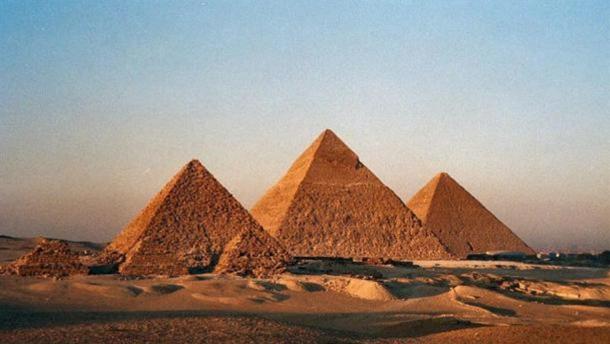
The Pyramids of Giza. (Bruno Girin, Flickr/CC BY-SA
2.0)
Science and technology change our expectations of the future. If one compares the sci-fi movies in the 50s with modern fare one can immediately feel how our attitudes towards the future have changed over time. This is due to our many breakthroughs and the new horizons and goals that seem attainable. Nevertheless, we fail to notice that advancing science and technology changes our attitudes towards the past, given the rise of new techniques and processes of investigating facts.
Building on the Ruins of the Ancestors
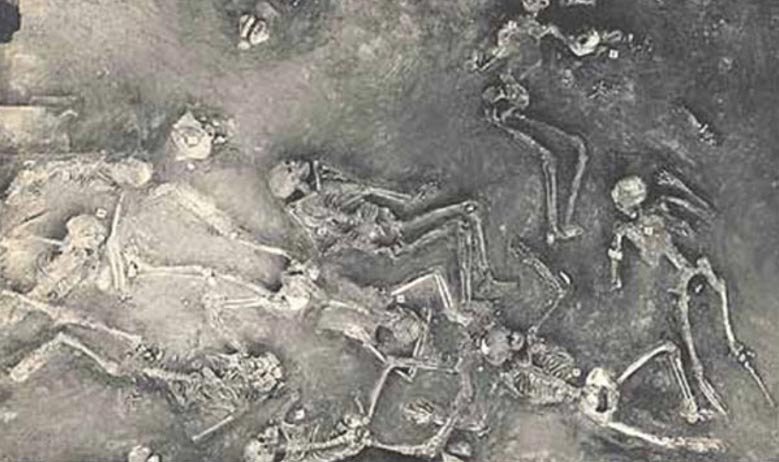
Painting of the many skeletons found at
Mohenjo Daro (Pakistan), an exceptional ancient metropolis reduced to ruins for
reasons unknown. Image source: Wikimedia
We have the Orion Correlation Theory (1993) advanced by Robert Bauval that suggests the three pyramids at Giza plateau were built mirroring the three stars in the Orion constellation, also known as Orion’s belt. Not only that, but Bauval goes further to observe that a shaft within the Great Pyramid was, at some point in the past, oriented towards the middle star of Orion’s belt, which is the star representing the same pyramid.
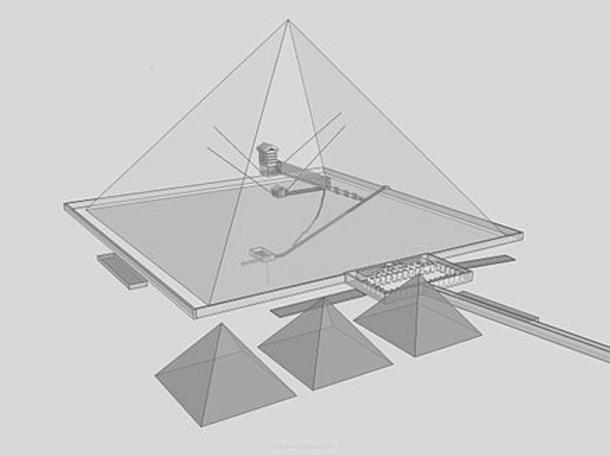
“Khufu's” pyramid at Giza shown with inner
shafts illustrated. (CC BY-SA 3.0)
These observations have huge implications when we relate them to an astronomical phenomenon called precession of the equinoxes. The phenomenon is a cycle the earth undergoes which lasts, according to NASA, 25,800 years. This cycle is manifested in the observable fact that the background stars and Zodiac constellations in the morning of the vernal equinoxes change across the millennia, making each Zodiac constellation last 2,125 years in those mornings when the day and night are of equal length. This cycle is either caused by the slow wobbling of the earth due to the moon’s gravitational pull, or by the whole solar system moving in a helical orbit.
The first scientific recognition of the precession cycle took place in ancient Greece (129 B.C.) by the astronomer Hipparchus. However, long before that, ancient Mesopotamia, Mesoamerica and Egypt somehow knew about the cycle and we do not know whether this knowledge was handed down from earlier times, or whether they scientifically discovered it themselves. This cycle tracks time across a large span and is, according to writer and journalist Graham Hancock, “extremely difficult to observe, and even harder to measure accurately, without sophisticated instrumentation.”
The Great Sphinx: Marking Time and Space

The Sphinx of Giza, Egypt. Source:
BigStockPhoto
The Orion Theory seems to give a better answer to the question ‘why’ but what about the ‘how’? No two blocks in the 2.3 million stone blocks have been found to be of equal size or weight in the great pyramid. How do they fit beautifully into a homogenous whole with an intended great precision? You would need a microprocessor to determine where each unique block, of an average of 2.5 to 15 tons, goes. It is now known in engineering and architecture that a structure that is built with unequal blocks is more likely to resist earthquakes and to last longer.
At this point it is even doubtful to think that ancient Egyptians designed and built the Giza Necropolis. We know many aspects of ancient Egyptian daily life with the minutest details. However, there is no single mention of: “Oh, by the way, we also built the pyramids!” in their hieroglyphs records and no hieroglyph inscription inside the three main pyramids.
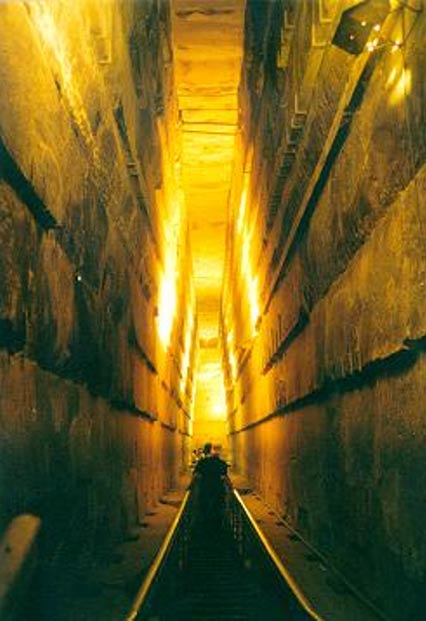
The Grand Gallery of the Great Pyramid of
Giza. (CC BY-SA 3.0)
Some evidence even suggests that the site predates the legendary flood. Encrustations of natural salt were found inside the great pyramid when it was opened for the first time. Also, in his Histories, Herodotus also reported that he observed in the surrounding area of the pyramids seashells and signs of salt water calcification. All this makes one doubt the conventional knowledge of the pyramid builders, the time they were built, and why and how they were built.
Were Humans Recovering from Cataclysm?
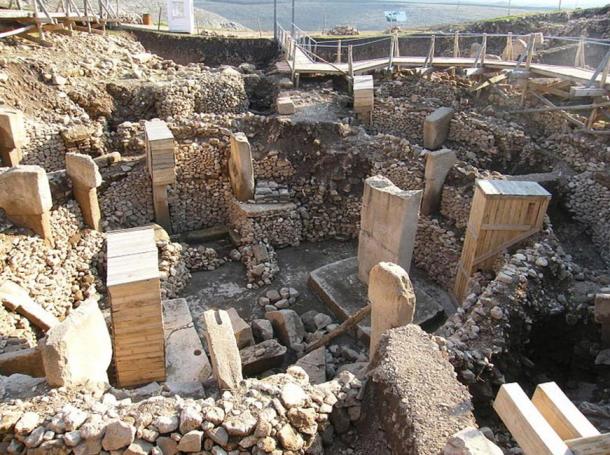
The ruins of Göbeklitepe in Turkey, the
oldest temple in the world. What do these mysterious stones communicate to us
about the very ancient past? Wikimedia Commons
All cultures seem to have started emerging simultaneously with no substantial signs of preliminary phases in the era that followed the great decline. They went from being hunter-gatherers to becoming citizens with rights and responsibilities.
Upon the Ruins of the Ancestors
– John Anthony West,
1979
This emergence of civilization was undoubtedly supported by ancient wisdom and this wisdom still lingers even up to present day. The heliocentric picture of the world has its earliest traces in the ancient Sanskrit texts (e.g. Yajnavalkya, ca. 900 BC, Aryabhata ca. 550 BC) and later Aristarchus of Samos (circa 230 BC). This makes the Copernican revolution rather a revival of lost knowledge. Add to that, the 12 Zodiac constellation artificial division with a precision of 30 degree in each constellation is untraceable to any culture.
“Contrary to history as we know it, in that remote period we call ‘prehistory’, there subsisted an embarrassing wealth of astronomical knowledge. And may I suggest that the more one looks into it, the more one feels that a race of scientific giants has preceded us.”
– Johnathan Gray, 2004
Electricity was not actually discovered but rediscovered. There are many items made of aluminum that have been found in archaeological sites, e.g. in the burial site of General Zhou Chu (265-420 AD) while aluminum is believed to have not been created until 1854 because the process of making it strictly requires electricity.

Ancient Hindu texts describe great battles
taking place and an unknown weapon that causes great destruction. A manuscript
illustration of the battle of Kurukshetra, recorded in the Mahabharata.
Image source: Wikipedia
Besides physics, ancient maps gave a push to maritime exploration. The Piri Reis map perplexes modern man for its accuracy and its depiction of Antarctica long before the continent’s discovery in 1819. The map shows with fine exactitude the continent without the ice cap, detailing mountains and rivers that correspond to the Swedish-British-Norwegian seismic-echo-sounding profile in the Antarctic Expedition of 1949 (Ohlmeyer, the USAF Commander, in a letter to Charles Hapgood, 1960).
In the meantime, academia preaches that the Antarctica landmass has been under the ice cap long before mankind even ‘evolved’.
“The difference between fiction and reality?
Fiction has to make sense.”
— Tom Clancy
Any ‘anomaly’ in science could be a twinkle of a new discovery or paradigm shift that may be left unnoticed or even denied for fear of misoneism—the hatred of change. A true scientific and intellectual honesty will never be achieved unless we take into consideration the anomalous by trying to adjust or even reconstruct our theoretical assumptions accordingly— until the anomalous, as Kuhn puts it, becomes expected. We are in a desperate need not only for a paradigm shift but, most importantly, for a scientific renaissance.
Knowing our past is of great value and has huge implications on the present and future. The past, the present and the future are all one chain of events. The more we know about the past, the more we know ourselves and where we are headed. The question that remains is: do the pyramids point to the date of the cataclysm?
References
Bauer, S. (2007). The history of the ancient world: From the earliest accounts to the fall of Rome. New York: W.W. Norton.
Cook, M., & Cook, M. (1967). Science and Mormonism; correlations, conflicts and conciliations,. Salt Lake City: [Deseret News Press].
Cox, R. (1997). The pillar of celestial fire: And the lost science of the ancient seers. Fairfield, Iowa: Sunstar Pub.
Dey, G. (2012). Gospel train. S.l.: Authorhouse.
Fix, W. (1978). Pyramid odyssey. New York: Mayflower Books.
Harold G. Coffin, (1969). Research on the Classic Joggins Petrified Trees. Creation Res. Soc. Annual pp. 35-44, 70
LaViolette, P. (2005). Earth under fire: Humanity's survival of the Ice Age. Rochester, Vt.: Bear & Co.
Malkowski, E. (2010). Ancient Egypt 39,000 BCE: The history, technology, and philosophy of Civilization X. Rochester, Vt.: Bear & Co.
New York Herald Tribune newspaper, 16 Feb. 1947.
Rupke, N.A., (1966). Prolegomena to a Study of Cataclysmal Sedimentation. Research Society Quarterly, Nutley, 3(1), 16-37.
Wohl, E. (2000). Inland flood hazards: Human, riparian, and aquatic communities. Cambridge: Cambridge University Press.
Bauval, R., & Gilbert, A. (1994). The Orion mystery: Unlocking the secrets of the Pyramids. New York: Crown.
Dinwiddie, J. (2001). Revelations: The Golden Elixir. Lincoln: iUniverse.
Gray, J. (2004). Dead men's secrets: Tantalising hints of a lost super race. Bloomington, Ind.: AuthorHouse.
Kuhn, T. (1970). The structure of scientific revolutions (2nd ed.). Chicago: University of Chicago Press.
West, J. (1979). Serpent in the sky: The high wisdom of Ancient Egypt. New York: Harper & Row.
From Ancient Origins
@ http://www.ancient-origins.net/opinion/ancient-civilizations-came-self-eradication-or-natural-cataclysm-part-i-003967
and http://www.ancient-origins.net/opinion-editorials/ancient-civilizations-came-building-ruins-ancestors-part-2-003977
For more information about lost civilisations see http://nexusilluminati.blogspot.com/search/label/lost%20civilisations
- Scroll down
through ‘Older Posts’ at the end of each section
Hope you like this
not for profit site -
It takes hours of work every day by
a genuinely incapacitated invalid to maintain, write, edit, research,
illustrate and publish this website from a tiny cabin in a remote forest
Like what we do? Please give anything
you can -
Contribute any amount and receive at
least one New Illuminati eBook!
(You can use a card
securely if you don’t use Paypal)
Please click below -
Spare Bitcoin
change?
For further enlightening
information enter a word or phrase into the random synchronistic search box @
the top left of http://nexusilluminati.blogspot.com
And see
New Illuminati – http://nexusilluminati.blogspot.com
New Illuminati on Facebook - https://www.facebook.com/the.new.illuminati
New Illuminati Youtube Channel - https://www.youtube.com/user/newilluminati/playlists
New Illuminati’s OWN Youtube Videos
-
New Illuminati on Google+ @ For
New Illuminati posts - https://plus.google.com/u/0/+RamAyana0/posts
New Illuminati on Twitter @ www.twitter.com/new_illuminati
New Illuminations –Art(icles) by
R. Ayana @ http://newilluminations.blogspot.com
The Her(m)etic Hermit - http://hermetic.blog.com
DISGRUNTLED SITE ADMINS PLEASE NOTE –
We provide a live link to your original material on your site (and
links via social networking services) - which raises your ranking on search
engines and helps spread your info further!
This site is published under Creative Commons (Attribution) CopyRIGHT
(unless an individual article or other item is declared otherwise by the copyright
holder). Reproduction for non-profit use is permitted
& encouraged - if you give attribution to the work & author and include
all links in the original (along with this or a similar notice).
Feel free to make non-commercial hard (printed) or software copies or
mirror sites - you never know how long something will stay glued to the web –
but remember attribution!
If you like what you see, please send a donation (no amount is too
small or too large) or leave a comment – and thanks for reading this far…
Live long and prosper! Together we can create the best of all possible
worlds…
From the New Illuminati – http://nexusilluminati.blogspot.com
No comments:
Post a Comment
Add your perspective to the conscious collective